| |
Date: | March
3rd, 2003 | | Type: | Review |
| Supplier: | VIA |
| Author: | mayhem |
| RRP: | $349.00
(AUS) |
With
people wanting smaller and smaller computers for obscure applications (such as
dedicated TV/DivX boxes or Internet Gateways etc) there was a need for a small
form factor fully integrated mainboard. Last year VIA introduced one of the smallest
commercially available motherboards, but unfortunately they (the EPIA-5000 and
EPIA-8000) were not powerful enough for peoples needs, knowing this VIA put more
research and design into their new model the EPIA-M 9000 which addresses most
of the issues of the previous board as well as sticking to the low form factor
Mini-ITX design. In
this review we get to test the new VIA EPIA-M and see just how powerful it is
so that we can compare it to its predecessor the EPIA-800 and more common personal
computers. 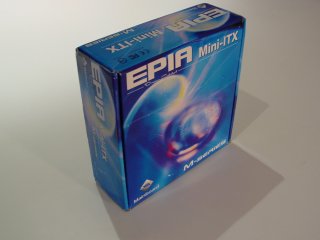
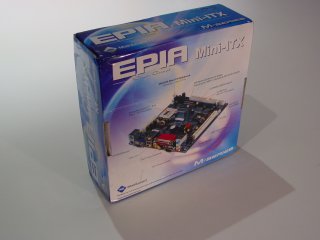
Introduction:
"The Mini-ITX mainboard form factor is the world's smallest native x86
mainboard measuring only 170mm x 170mm and enables the development of an infinite
variety of small form factor system platforms. More than 33% smaller than the
FlexATX mainboard form factor, the Mini-ITX allows for the development of entry-level
value PCs, Thin-Clients, wireless network devices, digital media systems, set-top
boxes and more. With the I/O ports as the tallest components on the board (including
the CPU cooler), the Mini-ITX mainboard is also becoming increasingly popular
among the rapidly emerging enthusiast user group, seeing the small size, quiet
operation and low profile as ideal for moving the PC to different parts of the
home from stylish case modifications for the living room to in-car PCs. The
VIA EPIA M-Series Mini-ITX Mainboard is a revolutionary, ultra-compact x86 platform
optimized for today's killer digital applications. At just 17cm x 17cm, Mini-ITX
is the world's smallest native x86 mainboard platform, and is fully compatible
with Microsoft® and Linux Operating Systems. Available with an embedded VIA Eden?™
ESP processor core for fanless systems with ultra low-power requirements, or an
embedded VIA C3™ E-Series processor for more demanding digital multimedia applications,
the EPIA M-Series is the perfect platform for a whole range of small form factor,
low-power digital media devices and home entertainment centers. The
EPIA M-Series' VIA Apollo CLE266 chipset features an embedded MPEG-2 decoder for
silky smooth DVD playback, and integrated 2D/3D graphics for a rich multimedia
experience. With the sizable memory bandwidth of DDR266 SDRAM and the high data
transfer speeds of ATA/133, the EPIA M-Series ensures the high performance levels
required of today's most popular digital media applications. The user's digital
media experience is further enhanced by support for 5.1 surround sound, courtesy
of the onboard VIA VT1616 6 Channel AC'97 codec. The
latest in high-bandwidth connectivity is supported with both IEEE 1394 and USB
2.0 connections provided, as well as S-Video and RCA TV-Out (NTSC & PAL) and 10/100
Ethernet for seamless broadband connectivity. The EPIA M-Series also offers support
for the latest LVDS embedded LCD panels, has one PCI slot for expandability options,
and is compatible with a full range of Mini-ITX chassis as well as FlexATX and
MicroATX chassis." - VIA Product:
The EPIA-M Mini-ITX package comes with just about everything you need (bar of
course memory, hard drive, dvd/cd-rom and a case :P). 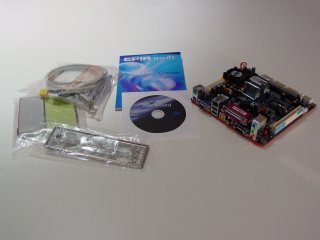
1
x EPIA-M 9000 C3 933 MHz All-In-One Board
1 x Drivers CD-ROM
1 x Manual
1
x Rear Panel Face Plate
1 x ATA100/133 IDE Cable
1 x ATA33 IDE Cable
1
x Floppy Drive Cable
1 x USB2.0/Firewire Bracket Below
you can see more detailed pictures of the mainboard itself. 

Specifications:
Although the Mini-ITX form factor is quite small, VIA managed to package many
useful features into the design as well as giving room for expandability.
| VIA
EPIA-M Mainboard Specification |
| Processor |
- VIA C3/EDEN EBGA
Processor | | Chipset |
- VIA CLE266 North
Bridge
- VT8235 South Bridge |
| System
Memory | -
1 DDR266 DIMM socket
- Up to 1GB memory size |
| VGA |
- Integrated VIA
CastleRock AGP graphics with MPEG-2 decoder |
| Expansion
Slots | -
1 PCI | | Onboard
IDE | -
2 X UltraDMA 133/100/66 Connector |
| Onboard
Floppy | -
1 x FDD Connector |
| Onboard
LAN | -
VIA VT6103 10/100 Base-T Ethernet PHY |
| Onboard
Audio | -
VIA VT1616 6 channel AC'97 Codec |
| Onboard
TV Out | -
VIA VT1622 TV out |
| Onboard
1394 | -
VIA VT6307S IEEE 1394 Firewire |
| Onboard
I/O Connectors |
- 1 USB connectors for 2 additional USB 2.0 ports
- 2 1394 connectors for
2 1394 ports
- Front-panel audio connectors (Mic and Line Out)
- CD Audio-in
connector
- SIR connector
- CIR connector
- Wake-on-LAN, Wake-on-Ring
- CPU/Sys FAN/Fan 3
- System intrusion connector
- 1 I2C connector
- 1 LVDS connector (Optional)
- Serial port connector for second com port |
| Back
Panel I/O | -
1 PS2 mouse port
- 1 PS2 keyboard port
- 1 Parallel
- 1 RJ-45 LAN
port
- 1 Serial port
- 2 USB 2.0 ports
- 1 VGA port
- 1 RCA port
(SPDIF or TV out)
- 1 S-Video port
- 3 Audio jacks: line-out, line-in
and mic-in; can be switched to 6 channel output |
| Application |
- VIA FliteDeck™
Luxurious Utility
- MissionControl-H/W Monitoring, Remote SNMP management
- FlashPort-Live BIOS Flash
- SysProbe-Live DMI Browser |
| BIOS |
- Award BIOS
- 2/4Mbit flash memory |
| System
Monitoring & Management | -
CPU temperature monitoring
- CPU voltage monitoring
- Wake-on-LAN, Keyboard-Power-on,
Timer-Power-on- System power management
- AC power failure recovery |
| Form
Factor | -
Mini-ITX (4 layer)
- 17 cm x 17 cm | 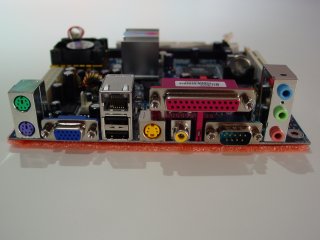
As
you can see from the above picture of the back of the mainboard, pretty much all
the connections are catered for, the only connections not provided here are the
2 x USB 2.0 and 2 x IEEE1394 Firewire ports which are provided on the PCI bracket
which plugs into headers on the mainboard. The
CPU uses a heatsink and fan that you would see commonly on today's ATX northbridge's.
The heatsink on the EPIA-M is the same that was on the original EPIA, a gold anodized
low profile heatsink with a low noise fan running at 6200RPM which pushes around
7.9 cubic feet of air a minute, producing about 29dB. VIA
changed the CPU to the C3 E-Series processor running at 933 MHz, from the C3 running
at 800 MHz on the original EPIA, the new C3-E CPU puts out less heat than the
previous C3 on the EPIA. This new C3-E processor is made on a 0.13 micron process
and has the worlds smallest x86 processor die size of 52mm^2. It has 128kb of
integrated Level 1 and 64kb of level 2 cache running at full speed. As on the
EPIA, the CPU is in a EBGA (Enhances Ball Grid Array) package, which means it
is directly attached to the motherboard. This means that the CPU cannot be upgraded
in the future. 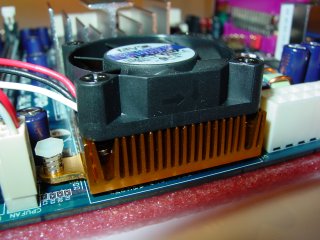
The
EPIA-M uses a VIA CLE266 northbridge chipset, which allows a FSB (front side bus)
of 66, 100 or 133 MHz. The CLE-266 has a built in graphics chipset which provides
the system with MPEG-2 (DVD) decoding, this is on an internal 8x AGP bus. The
new chipset also allows for DDR-SDRAM support (giving the system a bit more memory
performance over the previous EPIA which only supported SDRAM). The
southbridge of the EPIA-M uses the VT8235 chipset allowing for up to 6 USB 2.0
ports (although only a max of 4 on the EPIA-M), ATA-133 support, 6-Channel AC-97
and a VIA 10/100 Ethernet Adapter. Through the BIOS of the EPIA-M the three 3.5mm
audio jacks can be set from LINE IN, LINE OUT, MIC IN to FRONT OUT, REAR OUT and
SUB-WOOFER OUT allowing a surround sound output, which is idea for movie playback. VIA
also decided to upgrade the TV-Out chipset to the VT1622M as opposed to the previous
VT1621, as a result the TV output capabilities have been increased to support
1024x768 in both NTSC and PAL formats. The "M" on the end of the chipset
name stands for Macrovision, which means that output to DVD's, VHS or other formats
is not possible, this doesn't not however affect the standard viewing on a TV
set. Another
big change is the addition of a floppy drive connector to the EPIA-M which the
previous EPIA didn't have. Since alot of people didn't like the lack of a floppy
drive connector, VIA decided to incorporate one into this new model. For those
people like me who don't use a floppy drive, it doesn't cause us any problems.
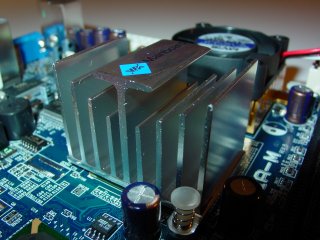
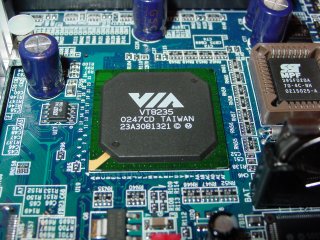 Setup:
The following system was built using the supplied EPIA-M mainboard in order to
perform the necessary tests. - EPIA
M 9000 Mainboard
- 256MB
TwinMOS PC2700 Memory
- AOpen
300 Watt PSU
- Seagate
Barracuda IV 40GB 7200RPM IDE Hard Drive
- Panasonic
16x Tray Loading DVD (DVD-120)
Although
the PSU and Memory were a bit of an overkill the extra power they could handle
was not used during testing and thus should have had no effect on the overall
results of this review. 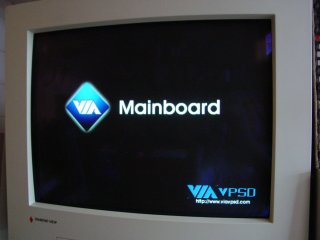
Above
is a picture of the BIOS pre-boot screen, looks classy if you ask me. Testing:
Since most people use the EPIA systems for specialised purposes (such as a Jukebox,
TV box etc) we thought it best to base the testing around these functions. The
first three tests performed were based on the video performance of the system
(i.e. DivX, DVD and TV-Out): DivX:
A number of different tests were run on DivX, firstly playing a file from the
local hard disk, seconds across the 100mbit network from the file server. Both
methods were fine and even on the highest quality DivX files (thus the largest
movies roughly 2GB in size) the system didn't show any sign of problems. Also
when entering and exiting fullscreen mode there where no problems. DVD:
Two DVD titles were selected for playback to see how the unit faired. The first
title was "A Knight's Tale" and the second "Finally Fantasy",
both movies played back in fullscreen without any problems, pauses or screen corruption's
at all. The only noticeable slow down that the system suffered seemed to be when
exiting full screen mode, the video card took a second or so to refresh the screen
and display the Desktop in the background. TV-Out:
With a TV connected to the RCA output of the EPIA-M all that was needed to do
in order to get the TV out functionality working flawless was to se, both in BIOS
and windows, the TV output format to be PAL (as it defaulted to NTSC). DVD's and
files from the Hard Disk (such as DivX and MPEG) were played back perfectly on
the TV. One really good thing about the settings that the VIA supplied drivers
give you is that when you enable TV output (in the Control Panel -> Display
Properties -> Advanced -> Output) it also modifies the windows text to display
in large text format so that it makes the system easier to use through the TV
(this is ideal for those people wanting to use this system solely for a TV box
or in-car computer where the only output is an LCD screen running from the RCA
output). NEXT:
More testing, results and conclusion
| 
